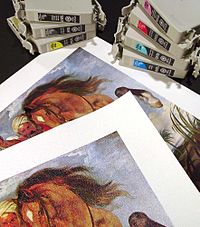| This article needs additional citations for verification. Please help improve this article by adding citations to reliable sources. Unsourced material may be challenged and removed. Find sources: "CcMmYK color model" – news · newspapers · books · scholar · JSTOR (August 2007) (Learn how and when to remove this message) |

CcMmYK, sometimes referred to as CMYKLcLm or CMYKcm, is a six-color printing process used in some inkjet printers optimized for photo printing. It complements the more common four-color CMYK process, which uses only cyan, magenta, yellow and black, by adding light cyan and light magenta. Individually, light cyan is often abbreviated Lc or c, and light magenta Lm or m.
Advantages of CcMmYK over CMYK
CcMmYK colorants reduce graininess in the middle tone region. This reduced graininess typically improves the photographic appearance of blue skies and some flesh tones.
The most noticeable result of using light cyan and light magenta inks is the removal of a distinct and harsh dither dot appearance in prints that use light shades of cyan or magenta produced with only the CMYK inks. Usually when printing a dark color the printer will saturate an area with colored ink dots, and conversely, for a light color it will use fewer ink dots. The resulting graininess is hard to notice with yellow because yellow is perceived as a very light color, but sparse individual cyan and magenta ink dots, e.g. for a pale blue sky, can be discernible against a white background.
By using light cyan and light magenta, the printer can saturate areas that would typically use halftoning with these inks to remove the look of sparse magenta and cyan dots. The disadvantage is that the printer needs approximately twice as much light cyan and magenta ink to achieve the same saturation as it would using pure cyan and magenta inks. The result, however, is significantly better for some images.
References
- Uwe Steinmueller and Juergen Gulbins (2006). The Art of Fine Art Printing: Using today's Inkjet Printers for Quality Prints. Uwe Steinmueller. ISBN 0-9787497-0-7.
- Son, Chang-Hwan; Yun-Tae Kim; Cheol-Hee Lee; Yeong-Ho Ha (2004). Reiner Eschbach (ed.). Color Imaging IX: Processing, Hardcopy, and Applications (PDF). SPIE and IS&T. pp. 110–120. Archived from the original (PDF) on 2015-07-07. Retrieved 2013-07-16.
| Color space | |
|---|---|
| CAM | |
| CIE | |
| RGB | |
| Y′UV | |
| Other | |
| Color systems and standards | |
| For the vision capacities of organisms or machines, see | |
This color-related article is a stub. You can help Misplaced Pages by expanding it. |